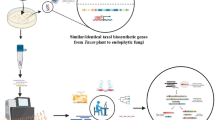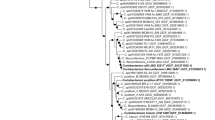Abstract
Thirty-five clonal, axenic Arthrospira strains were screened for their ability to grow heterotrophically on six carbon sources (20 mM). Glucose (34 strains) and fructose (24 strains) were the only substrates permitting growth in the dark. In some assays, however, not every replicate grew and, in at least one strain (D867), repeat assays over 2 years on material maintained in the light indicated that the ability to use fructose in the dark had become lost. Four further strains from other culture collections were compared, because they are presumed duplicates of three of the main set of strains; in at least three cases the duplicates of a pair differed in their ability to use fructose in the dark. In another comparison, where straight and helical morphotypes of the same strain could be compared, two of the four straight morphotypes (including one duplicate strain) grew with glucose in the dark, whereas none of the helical morphotypes did so. It is suggested that genetic drift has led to losses in the ability to grow heterotrophically in some strains.
Ten of the main set of strains were tested for their ability to grow photoheterotrophically with four of the carbon sources (glucose, maltose, fructose, sucrose). All grew with glucose and maltose, but none with fructose or sucrose, in spite of the fact that eight (of this subset) grew with fructose in the dark. Sucrose led to most of a culture lysing, but often with short fragments of trichome surviving and subsequently giving rise to a normal culture. All the surviving cells in the transitory stage showed the presence of large intrathylakoidal granules, which had disappeared by the time that the culture had returned to a healthy state. Bleaching and recovery were more rapid at 70 than 10 μmol photon m−2 s−1. The presence of DCMU prevented this recovery. There was no bleaching when an inoculum of the recovered material was subcultured to medium with sucrose.
Similar content being viewed by others
Abbreviations
- DCMU:
-
3-(3,4-dichlorophenyl)-1,1-dimethylurea
- CCALA:
-
Culture Collection of Algal Laboratory, Institute of Botany, Trebon, Czech Republic
- CCAP:
-
Culture Collection of Algae and Protozoa, UK
- PCC:
-
Pasteur Culture Collection of Cyanobacterial Strains, Paris, France
- SAG:
-
Sammlung von Algenkulturen der Universität Göttingen, Germany
- UTEX:
-
Culture Collection of Algae at the University of Texas at Austin, Austin, Texas, USA
References
Belay A (2002) The potential application of Spirulina (Arthrospira) as a nutritional and therapeutic supplement in health management. J. Am. Nutraceutical Assoc. 5: 27–48.
Bishop NI (1958) The influence of the herbicide, DCMU, on the oxygen-evolving system of photosynthesis. Biochim. biophys. Acta 27: 205–206.
Chen F, Zhang Y (1997) High cell density mixotrophic culture of Spirulina platensis on glucose for phycocyanin production using a fed-batch system. Enzyme Microbiol. Technol. 20: 221–224.
Flores E, Schmetterer G (1986) Interaction of fructose with the glucose permease of the cyanobacterium Synechocystis sp. strain 6803. J. Bact. 166: 693–696.
Hihara Y, Ikeuchi M (1997) Mutation in a novel gene required for photomixotrophic growth leads to enhanced photoautotrophic growth of Synechocystis sp. PCC6803. Photosynthesis Res. 53: 243–252.
Joset F, Buchou T, Zhang CC, Jeanjean R (1988) Physiological and genetic analysis of the glucose-fructose permeation system in two Synechocystis species. Arch. Microbiol. 149: 417–421.
Kenyon CN, Rippka R, Stanier RY (1972) Fatty acid composition and physiological properties of some filamentous blue-green algae. Arch. Mikrobiol. 83: 216–236.
Khoja TM, Whitton BA (1971) Heterotrophic growth of blue-green algae. Arch. Mikrobiol. 79: 280–282.
Lang NJ, Krupp JM, Koller AL (1987) Morphological and ultrastructural changes in vegetative cells and heterocysts of Anabaena variabilis grown with fructose. J. Bact. 169: 920–923.
Leach CK, Carr NG (1970) Electron transport and oxidative phosphorylation in the blue-green alga Anabaena variabilis. J. gen. Microbiol. 64: 55–77.
Lee CH, Kim HS, Kwon GS, Oh HM, Kang SM, Kwon TJ, Yoon BD (1995) Purification and characterization of an alkaline protease produced by a Xanthomonas sp. YL-37. J. Microbiol. 33: 115–119.
Marquez FJ, Sasaki K, Kakizono T, Nishio N, Nagai S (1993) Growth characteristics of Spirulina platensis in mixotrophic and heterotrophic conditions. J. Ferment. Bioeng. 76: 408–410.
Marquez FJ, Nishio N, Nagai S, Sasaki K (1995) Enhancement of biomass and pigment production during growth of Spirulina platensis in mixotrophic culture. J. Chem. Tech. Biotechnol. 62: 159–164.
Mühling M, Belay A, Whitton BA (2005) Screening Arthrospira (Spirulina) strains for heterotrophy. J. appl. Phycol. 17.
Mühling M, Harris N, Belay A, Whitton BA (2003) Reversal of helix orientation in the cyanobacterium Arthrospira. J. Phycol. 39: 360–367.
Ogawa T, Terui G (1970) Studies on the growth of Spirulina platensis. (I) On the pure culture of Spirulina platensis. J. Ferment. Technol. 48: 361–367.
Ogawa T, Terui G (1972) Growth kinetics of Spirulina platensis in auxotrophic and mixotrophic cultures. In: Terui G (ed), Fermentation Technology Today, Society of Fermentation Technology, Tokyo, pp. 543–549.
Pearce J, Carr NG (1969) The incorporation and metabolism of glucose by Anabaena variabilis. J. gen. Microbiol. 54: 451–462.
Pelroy RA, Bassham JA (1973) Efficiency of energy conversion by aerobic glucose metabolism in Aphanocapsa 6714. J. Bact. 115: 937–942.
Rippka R (1972) Photoheterotrophy and chemoheterotrophy among unicellular blue-green algae. Arch. Mikrobiol. 87: 93–98.
Stanier RY (1973): Autotrophy and heterotrophy in unicellular blue-green algae. In: Carr NG, Whitton BA (eds), Biology of the Blue-Green Algae, Blackwell, Oxford, pp. 501–518.
Schneegurt MA, Sherman DM, Sherman LA (1997) Growth, physiology, and ultrastructure of a diazotrophic cyanobacterium, Cyanothece sp. strain ATCC 51142, in mixotrophic and chemoheterotrophic cultures. J. Phycol. 33: 632–642.
Tomaselli L, Pelosi E, Paoletti C (1978) Fotoassimilazione di composti organici in Spirulina platensis e S. maxima. In Proceedings of the 18th Congress National Italian Society Microbiology, Fiuggi Terme, Italy.
Vonshak A, Tomaselli L. 2000. Arthrospira (Spirulina): Systematics and ecophysiology. In: Whitton BA, Potts M (eds), The Ecology of Cyanobacteria, Kluwer, Dordrecht, pp. 505–522.
Waterbury JB, Stanier RY (1981) Isolation and growth of cyanobacteria from marine and hypersaline environments. In: Starr MP, Stolp H, Trüper HG, Balows A, Schlegel HG (eds), The Prokaryotes, Vol. 1, Springer-Verlag, Berlin, pp. 247–256.
Zarrouk C (1966) Contribution à l’étude d’une cyanophycée. Influence de divers facteurs physiques et chimiques sur la croissance et la photosynthèse de Spirulina maxima (Setch. et Gardner) Geitl. Ph.D. Thesis, Paris.
Zhang CC, Jeanjean R, Joset F (1998) Obligate phototrophy in cyanobacteria: More than a lack of sugar transport. FEMS Microbiol. Lett. 161: 285–292.
Author information
Authors and Affiliations
Corresponding author
Rights and permissions
About this article
Cite this article
Mühling, M., Belay, A. & Whitton, B.A. Screening Arthrospira (Spirulina) strains for heterotrophy. J Appl Phycol 17, 129–135 (2005). https://doi.org/10.1007/s10811-005-7214-8
Received:
Revised:
Accepted:
Issue Date:
DOI: https://doi.org/10.1007/s10811-005-7214-8




